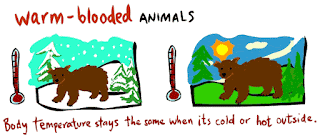What Is a Bird?
 |
| Source: Wikipedia |
The bodies of birds are adapted for flight.
The bones of a bird's forelimbs form wings. Many of a bird's bones are nearly hollow.
Flying birds have large chest muscles that move the wings.
Feathers are a major adaptation that help birds fly.
Feathers
 |
| Source: Bird Academy |
A contour feather is one of the large feathers that give shape to a bird's body. The long contour feathers that extend beyond the body on the wings and tail are called flight feathers. When a bird flies, these feathers help it balance and steer.
Down feathers are specialized to trap heat and keep the bird warm. Down feathers are found right next to a bird's skin.
Down feathers are soft and flexible.
Food
 |
| Source: dixonapbio-taxonomywiki-2016 |
Many birds have an internal storage tank, or crop, that allows them to store food inside the body after swallowing it.
Delivering Oxygen to Cells
Birds have a system of air sacs in their body that connects to the lungs. The air sacs enable birds to extract much more oxygen from each breath of air than other animals can.
Birds have hearts with four chambers - two atria and two ventricles.
Nervous System and Senses
In order to fly, birds must have very quick reactions
A bird can react quickly because of its well-developed brain and finely tuned senses of sight and hearing.
Diversity of Birds
In addition to adaptations for flight, birds have adaptations - such as the shapes of their legs, claws, and bills - for living in widely diverse environments.




















